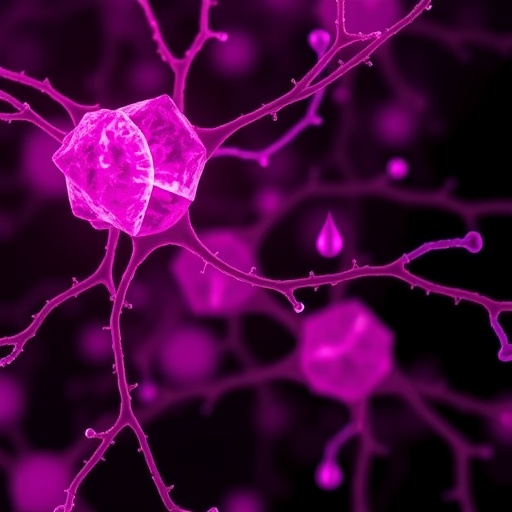Philadelphia, August 20, 2025 – A groundbreaking study emerging from a collaborative effort between the University of Pennsylvania School of Veterinary Medicine (Penn Vet) and the Children’s Hospital of Philadelphia (CHOP) has shed new light on the critical role mitochondria play in maintaining blood-brain barrier (BBB) integrity, specifically within the context of 22q.11.2 deletion syndrome (22qDS). This genetic condition, affecting a segment of chromosome 22, is known for its profound association with neuropsychiatric disorders, including a dramatically increased risk for psychosis and schizophrenia. The new research reveals that mitochondrial dysfunction significantly undermines BBB function in 22qDS, and, remarkably, that this dysfunction can be partially reversed through the administration of bezafibrate, a pharmaceutically approved cholesterol-modulating drug. Published today in Science Translational Medicine, these findings open a promising therapeutic avenue not only for 22qDS but also for potentially broader neuropsychiatric conditions involving BBB compromise.
The blood-brain barrier is an essential, highly selective vascular structure that tightly regulates the passage of molecules between the circulating blood and the central nervous system. By restricting the entry of harmful substances while allowing essential nutrients to pass, the BBB preserves the delicate cerebral milieu necessary for proper neural function. Intriguingly, the BBB endothelial cells contain a remarkably high density of mitochondria compared to endothelial cells elsewhere in the body, indicating a substantial energy demand intrinsic to their barrier function. Prior to this study, while mitochondrial dysfunction had been implicated in various neurodevelopmental and neurodegenerative disorders, its direct role in BBB integrity remained largely unexplored, especially in the complex pathological landscape of 22qDS.
The 22q11.2 deletion syndrome is a multifaceted genetic disorder resulting from the deletion of a small but critical region on chromosome 22 that encompasses approximately 30 to 50 genes, including six essential mitochondrial genes. Clinically, 22qDS manifests as a spectrum of phenotypes, ranging from cardiac anomalies to immune deficiencies, but what has increasingly captured the scientific community’s attention is the syndrome’s profound impact on brain development and function. Individuals with 22qDS face a 25-fold increased lifetime risk of developing psychosis, and schizophrenia diagnoses are prevalent in roughly 25% of affected patients. This confluence of genetic vulnerability and psychiatric pathology renders 22qDS an invaluable model for understanding neuropsychiatric diseases.
.adsslot_xzTsjYqKF6{ width:728px !important; height:90px !important; }
@media (max-width:1199px) { .adsslot_xzTsjYqKF6{ width:468px !important; height:60px !important; } }
@media (max-width:767px) { .adsslot_xzTsjYqKF6{ width:320px !important; height:50px !important; } }
ADVERTISEMENT
Within this intricate backdrop, researchers employed a multi-pronged experimental framework, combining human induced pluripotent stem cell (iPSC)-derived brain microvascular endothelial cells from individuals with 22qDS and corresponding BBB endothelial cells harvested from a validated preclinical mouse model bearing the same chromosomal deletion. This paired approach allowed the team to interrogate mitochondrial performance, BBB permeability, and the potential for pharmacologic remediation with remarkable precision. Their experiments unequivocally demonstrated that mitochondrial energy production was compromised in 22qDS models, translating to a “leaky” or dysfunctional BBB that likely facilitates aberrant molecular and cellular communication between the brain and systemic circulation.
One of the most compelling facets of the study was the identification of bezafibrate, an established lipid-lowering agent and a known activator of mitochondrial biogenesis and turnover, as a therapeutic candidate capable of rescuing BBB integrity. When administered to 22qDS mouse models and applied to human iPSC-derived endothelial cells, bezafibrate enhanced mitochondrial respiration, restored barrier tightness, and normalized the expression of critical endothelial junctional proteins. These biochemical and cellular improvements corresponded with a striking reversal of social memory deficits in the animal model—a behavioral abnormality tightly linked to both BBB compromise and psychiatric symptomatology. This preclinical evidence not only substantiates the mitochondrial basis of BBB dysfunction in 22qDS but also highlights bezafibrate’s potential as a repurposed drug for mitigating neuropsychiatric symptoms.
The implications of these findings ripple far beyond this rare genetic syndrome. Given the mounting recognition that BBB disruption is a common denominator in many neuropsychiatric and neurodegenerative disorders, targeting mitochondrial function within brain endothelial cells may represent a transformative approach to disease modification. The collaborative research team, led by Drs. Jorge Iván Alvarez of Penn Vet and Stewart A. Anderson of CHOP, emphasized the significance of a “One Health” perspective—integrating veterinary, biomedical, and clinical expertise—to unravel the complexities of mitochondrial influence on neurovascular health.
At the molecular level, the study detailed the restoration of tight junction proteins such as claudin-5 and occludin upon bezafibrate treatment, crucial components in the architecture of the BBB that prevent paracellular leakage. Enhanced mitochondrial function was evidenced by increased ATP production and improved oxidative phosphorylation metrics, indicating rejuvenated cellular bioenergetics. This mitochondrial revival was critical not only for maintaining the structural integrity of the endothelial monolayer but also for preserving the dynamic signaling necessary for BBB adaptability and response to physiological stress.
Behaviorally, the preclinical mouse model exhibited pronounced social memory impairments, mirroring cognitive and social deficits seen clinically in schizophrenia and other psychiatric disorders associated with 22qDS. The reversal of these behavioral phenotypes following mitochondrial enhancement is a compelling demonstration that targeting cellular metabolism within the vascular component of the brain can exert far-reaching neurofunctional benefits. This insight reframes some psychiatric symptoms as downstream consequences of vascular and metabolic dysregulation rather than purely neuronal dysfunction.
The research was supported by a constellation of funding sources, including the Uytengsu-Hamilton 22q11 Neuropsychiatry Research Program at Stanford’s Maternal and Child Health Research Institute, multiple NIH grants, the Howard Hughes Medical Institute, and private foundations. This broad financial backing reflects the high priority accorded to deciphering neuropsychiatric disease mechanisms and the translational potential of mitochondrial-targeted therapies.
CHOP’s leadership in pediatric neuropsychiatric research, boasting the world’s largest clinic dedicated to 22qDS, alongside Penn Vet’s distinctive expertise in veterinary biomedical research, particularly in mitochondrial biology and regenerative medicine, created a uniquely fertile environment for this discovery. Their combined efforts exemplify cross-disciplinary innovation, leveraging stem cell technologies, advanced imaging, behavioral paradigms, and pharmacology to tackle a formidable medical challenge.
Looking forward, clinical trials will be indispensable to determine the safety and efficacy of bezafibrate and related mitochondrial activators in patients with 22qDS and potentially other neuropsychiatric conditions marked by BBB dysfunction. Should these trials confirm the preclinical promise, it would mark a paradigm shift toward targeting vascular bioenergetics as a means to mitigate cognitive and psychiatric impairments. This study not only advances fundamental science but also fuels hope for transformative treatments that improve quality of life for patients grappling with these complex disorders.
Subject of Research: Animals
Article Title: Bezafibrate improves mitochondrial function, blood-brain barrier integrity and social deficits in models of 22q11.2 deletion syndrome
News Publication Date: 20-Aug-2025
Web References: https://doi.org/10.1126/scitranslmed.ads2116
References: Crockett et al, “Bezafibrate improves mitochondrial function, blood-brain barrier integrity, and social deficits in models of 22q11.2 deletion syndrome.” Sci Transl Med. Online August 20, 2025. DOI: 10.1126/scitranslmed.ads2116.
Image Credits: The Alvarez lab of the University of Pennsylvania School of Veterinary Medicine
Keywords: Genetic disorders, Pediatrics
Tags: 22qDS and its implicationsadvances inbezafibrate treatment for mitochondrial issuesblood-brain barrier integrity in 22q.11.2 deletion syndromegenetic influence on neurovascular healthmitochondrial dysfunction and neurovascular functionmitochondrial role in blood-brain barriermitochondrial vulnerability in neuropsychiatric disordersneuropsychiatric conditions and BBB compromisepsychosis and schizophrenia risk factorstherapeutic approaches for neuropsychiatric disordersUniversity of Pennsylvania and CHOP collaboration





